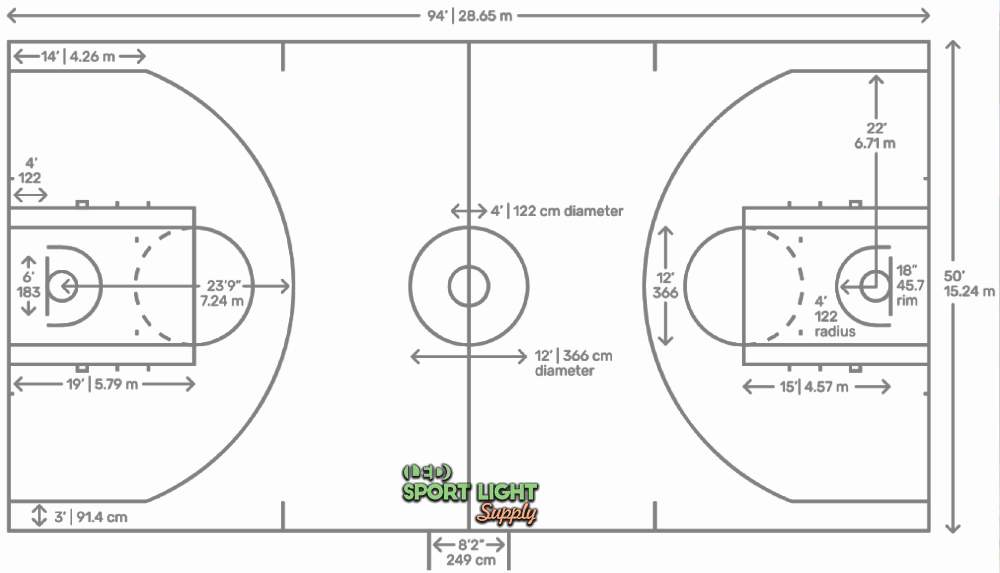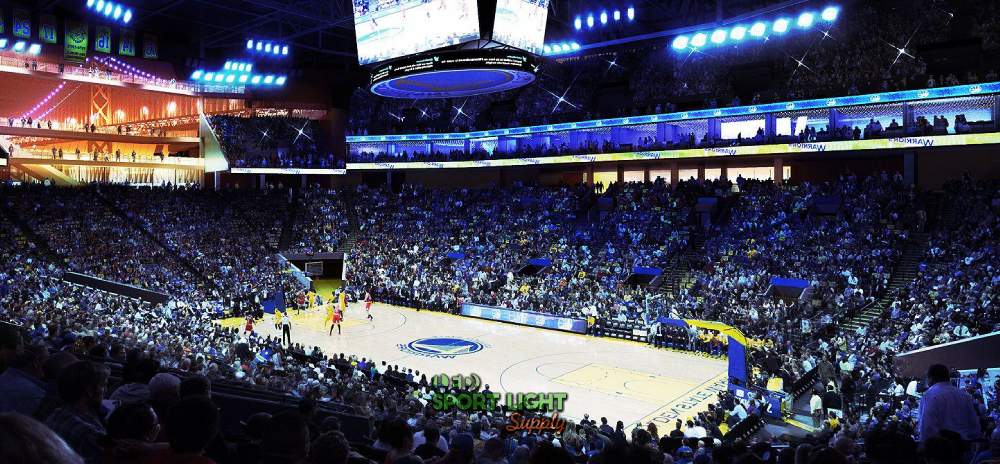Basketball is a dynamic and fast-paced game that relies on precision, strategy, and speed. To ensure that players can perform to the best of their abilities, the basketball court is designed to meet specific regulations and standards. Alongside the court’s dimensions, the role of high-quality lighting plays a significant part in enhancing the game experience, both for players and spectators. The combination of standardized court measurements and advanced lighting systems ensures optimal visibility, safety, and fairness throughout the game.
Table of Contents
Toggle
A regulation basketball court is precisely measured to cater to the flow and demands of the game. The standard length of a professional basketball court is 94 feet, and it measures 50 feet in width. These dimensions are applied across all major competitions, including professional leagues and collegiate tournaments, ensuring consistency and fairness. Such a large space is needed to allow for quick movements, intricate strategies, and a fast pace of play.
The court is divided into two halves by a midcourt line. Each half of the court contains a key area, also known as the paint, which plays a significant role in defining where players can position themselves during play. The key area is 16 feet deep, extending from the baseline, and spans 19 feet in width. This design allows players to maneuver and set up plays while maintaining a regulated structure for offensive and defensive strategies.
The three-point line, another key feature of the court, is an arc that starts from the baseline and extends outward. The line is set at a distance of 23.75 feet from the basket at its farthest point, allowing players to take shots from long-range. This added depth introduces more strategy to the game, challenging players to think quickly and execute their moves with precision.
The surface of the court is typically made from high-quality hardwood, chosen for its durability and responsiveness. It is usually finished with a smooth varnish to provide optimal grip for players. The various lines drawn on the court, such as the baseline, sideline, and free-throw line, create clear boundaries that define gameplay zones and ensure that every movement is within the scope of the game’s rules.
Beyond the court’s overall size, several key measurements help shape the structure of the game. The height of the basketball hoop is standardized at 10 feet above the playing surface, ensuring uniformity across all levels of play. This height is consistent in professional, collegiate, and even youth leagues, creating a level playing field regardless of the competition.
The backboard plays a significant role in the accuracy of shots. It measures 6 feet in width and 3.5 feet in height. Designed with a rectangular shape, the backboard serves not only as a support structure for the hoop but also as an aid for players attempting to shoot the ball. The backboard’s size ensures that players can use its surface for bank shots, which is an important aspect of scoring from different angles.

While the court dimensions and the physical setup of the game are crucial, lighting plays a huge role in ensuring that the game can be played with clarity and precision. High-quality lighting allows both players and spectators to see the action unfold clearly, without interference from shadows or glare. The role of lighting extends far beyond simply illuminating the court; it is integral to the overall experience of a basketball game.
In recent years, LED lighting has become the preferred choice for sports facilities. LED lights offer several advantages over traditional lighting systems, including improved brightness, energy efficiency, and reduced maintenance. These benefits make LED lighting an optimal solution for both professional arenas and recreational basketball courts. With LED lights, the court is evenly illuminated, providing clear visibility of the game in its entirety, from the movements of players to the positioning of the ball.
One of the primary advantages of LED lighting is its energy efficiency. Unlike traditional bulbs, LEDs use less power to produce the same amount of light. This efficiency is particularly important for basketball arenas, where the lights need to be on for long periods during games and events. Energy-efficient lighting systems not only reduce electricity consumption but also contribute to lowering the overall cost of operating a sports facility.
Another significant benefit of LED lighting is its long lifespan. LED lights typically last much longer than traditional halogen or incandescent bulbs, reducing the need for frequent replacements. This feature is beneficial for sports facilities that need to ensure consistent lighting for each game and event. The longer lifespan also minimizes maintenance efforts and associated costs, making LED lights a more cost-effective solution over time.
LED lighting is known for its ability to provide bright, clear illumination without creating shadows or uneven lighting across the court. The uniform distribution of light ensures that all areas of the court are well-lit, which is crucial for maintaining a high level of play. Players can rely on their ability to judge distances, angles, and timing without the distraction of dimly lit areas. The lighting contributes to the flow of the game, making it easier for players to make quick decisions and for referees to maintain accuracy in their calls.
Aside from ensuring that the game is played effectively, the role of lighting also extends to enhancing the safety of the players. When a court is properly lit, players can avoid accidents or injuries that might arise from not being able to see an incoming pass or the movement of an opponent. High-quality lighting systems improve overall visibility, making it easier for players to track the ball, maintain their positioning, and execute maneuvers with precision.
The benefits of effective lighting are not limited to the players on the court; the spectators in the stands also enjoy a more immersive and enjoyable experience. Properly lit courts ensure that fans can clearly follow the action, making for a more engaging atmosphere in arenas. The bright and even illumination highlights the details of the game, allowing spectators to appreciate the nuances of the sport, from the strategies of the players to the excitement of a buzzer-beater.
Beyond visibility, ensuring proper lighting can help prevent accidents. A well-lit court reduces the risk of players tripping or colliding with one another due to poorly illuminated spots. With LED lights providing consistent brightness, the chance of such accidents is minimized, making the court safer for everyone involved.
While the dimensions of a basketball court are set to ensure fairness and consistency, the proper lighting works hand in hand with these measurements to support the flow of the game. The size of the court requires sufficient illumination to highlight every detail, from the perimeter beyond the three-point line to the smallest movements in the key. LED lighting provides the necessary brightness across the court’s large area, ensuring that no part of the court is left in shadow and all measurements are clearly defined.
The combination of standardized court dimensions and high-quality lighting maximizes the effectiveness of both elements. The uniform distribution of light allows for a clear delineation of key areas, including the three-point line, the free-throw line, and the key, so players can make accurate judgments in real-time. The lighting supports the strategic nature of the game, where even the slightest movement or change in position can make a difference.
The regulation dimensions of a basketball court are integral to the structure of the game, offering a space that allows for both strategy and athleticism to unfold. When paired with advanced LED lighting systems, these measurements come to life in a way that ensures optimal performance, visibility, and safety for everyone involved. By providing clear illumination and evenly distributed light, LED lighting helps players perform their best while enhancing the overall experience for fans. With the proper lighting, a basketball court becomes more than just a playing surface—it becomes a well-designed environment that showcases the game’s skill, speed, and excitement.
Drop us a line to receive a free lighting design